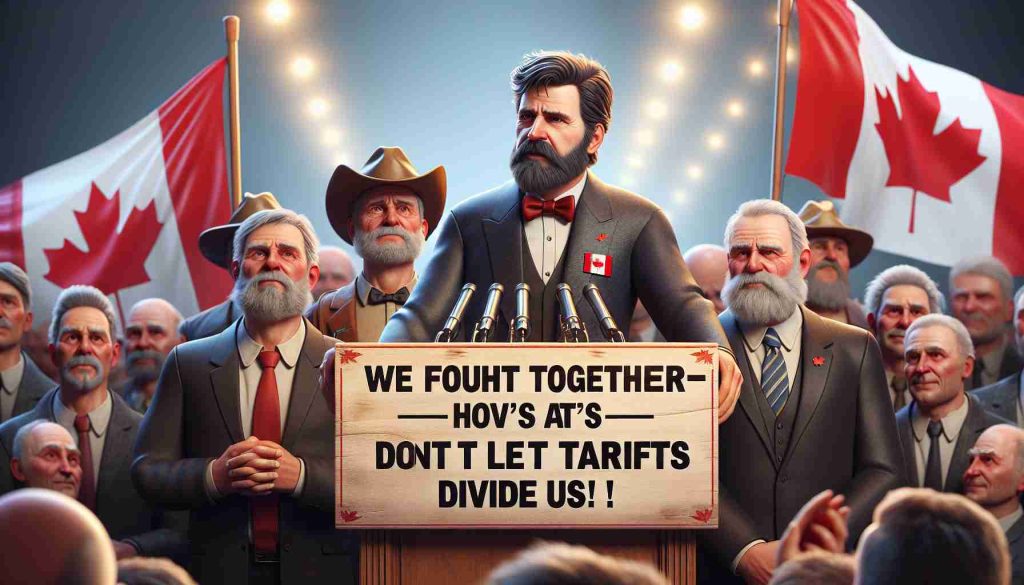- Prime Minister Trudeau emphasizes the importance of shared history and cooperation between Canada and the U.S.
- The 25% tariff imposed by President Trump threatens Canadian jobs and industries, such as automobile manufacturing.
- Trudeau highlights that American workers will also be negatively impacted by rising prices due to these tariffs.
- There is a strong call for diplomatic dialogue over escalating trade tensions.
- Collaboration is presented as essential for overcoming economic challenges faced by both nations.
- Trudeau urges a shift from punitive measures to a partnership approach to foster unity.
In a stirring address, Canadian Prime Minister Justin Trudeau reached out to Americans after President Donald Trump imposed a hefty 25% tariff on Canadian goods, igniting tensions between the neighboring nations. Trudeau, visibly passionate, invoked their shared history of sacrifice, reminding Americans of the countless battles fought side by side from Normandy to Kandahar.
While Trudeau emphasized diplomacy, he made it clear that his government will fiercely defend Canadian jobs and interests. He declared, “We’re not here to escalate the situation, but we will stand up for Canada!” In a heartfelt plea, he warned that the tariffs would also harm American workers, jeopardizing jobs in industries like auto manufacturing, where assembly plants could face closure.
Trudeau articulated the broader impact of these tariffs, indicating that rising prices would be felt by everyday Americans at grocery stores and gas stations. He urged Trump to shift course, advocating for a partnership rather than punishment amid rising tensions.
As Canada braces for the repercussions of this trade standoff, the key takeaway is loud and clear: when countries face economic strife, collaboration, not division, paves the way for lasting solutions. Trudeau’s emotional message serves as a reminder that in challenging times, unity is our strongest weapon. Will both nations find common ground before it’s too late?
Unity Amidst Tensions: How Canada and the U.S. Can Navigate Economic Challenges
Understanding the Current Trade Dynamics Between Canada and the U.S.
In light of the recent tariff impositions by the U.S., a closer examination of the economic, social, and diplomatic implications is necessary. The 25% tariff on Canadian goods implemented by President Donald Trump has sparked not only a reaction from Prime Minister Justin Trudeau but also broader discussions about trade relations.
# Key Takeaways on the Tariff Impact:
1. Economic Ramifications: The tariffs are set to increase costs for American consumers, leading to higher prices on everyday goods such as groceries and gas. This reality shines a light on the interconnectedness of the U.S. and Canadian economies, particularly in sectors where they depend on each other.
2. Job Security Concerns: Trudeau highlighted the potential job losses in both countries, particularly within the auto manufacturing industry. These concerns highlight the need for both governments to work collaboratively to protect jobs rather than engage in punitive trade measures.
3. Historical Context of Cooperation: The shared history of Canadian and American military collaboration serves as a foundation for strengthening ties rather than allowing economic strife to dictate relations.
Relevant Insights and Trends
– Long-term Market Forecasts: Analysts predict that if tariffs remain in place, both countries could witness a slowdown in economic growth. Long-term partnerships in trade are critical to maintaining stability and growth in industries reliant on cross-border trade.
– Pros and Cons of Tariffs:
– Pros: Protection of domestic industries from foreign competition in the short term.
– Cons: Higher consumer prices, potential job losses, and retaliation that can escalate economic tensions.
– Sustainability Implications: The interconnected supply chains between Canada and the U.S. complicate sustainability efforts. Tariffs may shift sourcing decisions, ultimately impacting carbon footprints and environmental policies shared by both nations.
Key Questions about the U.S.-Canada Trade Relationship
1. What are the potential long-term effects of the current tariffs on the U.S.-Canada relationship?
– The tariffs could lead to a prolonged trade war, severely affecting bilateral trade, jeopardizing jobs, and fostering economic uncertainty if a resolution is not reached.
2. How can both countries ensure mutual economic benefits moving forward?
– Pursuing trade agreements that focus on cooperation, innovation, and collective problem-solving rather than punitive measures could better serve the interests of both nations.
3. What role does public sentiment play in shaping trade policies?
– Public opinion on tariffs and trade policies is crucial; leaders must be attentive to the perspectives of workers and consumers, as they can influence decisions that ultimately lead to negotiations or escalations.
Suggested Links
Government of Canada: Explore insights on trade relations and economic data.
CSN: View speeches and debates regarding economic policies and international relations.
This unfolding narrative between Canada and the U.S. not only reflects economic interests but also emphasizes that in times of strife, collaboration is the key to resilience. The path forward should focus on unity and strategic partnerships to cultivate a stable economic future for both countries.
